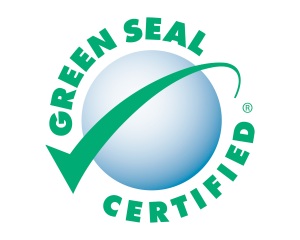 In late 2009, Green Seal[1] announced that they had developed a pilot sustainability standard for product manufacturers called “GS-C1”. This pilot standard recognizes socially and environmentally responsible product manufacturers so consumers can make informed choices while helping companies save money by reducing the resources they use and improving their brand and sales position.
In late 2009, Green Seal[1] announced that they had developed a pilot sustainability standard for product manufacturers called “GS-C1”. This pilot standard recognizes socially and environmentally responsible product manufacturers so consumers can make informed choices while helping companies save money by reducing the resources they use and improving their brand and sales position.
The Pilot Standard is now available for public review until September 30th, so it’s not too late to get your comments into the queue.
While the GS-C1 Pilot Sustainability Standard is under review, Green Seal will be piloting a certification program for consumer product manufacturers. The objective of the pilot certification program is to gain practical understanding about the GS-C1 requirements and procedures from companies that are going through the certification process.
Among the criteria included in the standard are:
- Transparency and accountability on environmental and social policies at the corporate level;
- Aggressive goals, commitments and achievements on environmental and social issues, including greenhouse gas reductions, water and waste, indigenous peoples’ rights and biological diversity;
- Supply-chain management and accountability practices;
- Life-cycle analysis of product lines and commitments to reduce environmental and health impacts from manufacturing, packaging, transport and end of life; and
- Third-party certification requirements to verify environmental and social responsibility of products
Specific to supply chain management issues, the standard awards points for developing and maintaining environmentally preferable purchasing policies (for its non-manufacturing purchasing functions), product life cycle issues, including product design, packaging, transport/logistics and end-of product life management. Perhaps the relevance to supply chain management is Section 3.3, Supplier Management. Focus is paid primarily to “first tier” and highest priority and sub-suppliers. Primary emphases are focused on:
- Identification of highest priority suppliers with the largest environmental and social impact/footprint
- Development and implementation of a documented management plan to reduce, in priority order, the social and environmental impacts of its highest-priority suppliers and sub-suppliers.
- Maintaining a Supplier “Code of Conduct”;
- Conform with Social Impact Assessment criteria described under SA8000 (including issues involving fair labor practices, bribery, governance and transparency);
- Monitoring of sub-suppliers (extra points are given if there is “Evidence of working with suppliers to resolve issues found during social and environmental compliance evaluations”.
- Accountability is recognized as well by designating a “senior officer” to be “responsible for enforcement of compliance with local laws, supplier Code of Conduct, and action plan for highest-priority suppliers and sub-suppliers.”
- Annually issue a publically available report on its supplier management activities and performance
The new standard represents a focal shift of sorts for Green Seal. The organizations efforts to date have focused on assessing and documenting the environmental footprint of a specific product. Now with GS-C1, the emphasis is now shifting to the entire product life cycle and all inputs and outputs from a supply chain perspective (the entire design, manufacturing, distribution and end of life management cycle). This standard is but one of several new standards under development, such as ULE 880 (see my earlier post) that are taking a whole systems approach to manufacturing- a refreshing and necessary step to manage consumption sustainably while enhancing manufacturing efficiency.
Some companies are not waiting around for the specifications to be completed. AU Optronics Corporation (AUO) is one of many examples of companies that are adapting to the ‘new normal’ in supply chain management, where environmental issues and social accountability are factored into daily operations. AUO built one of a handful of factories that are (Leadership in Energy and Environment Design (LEED) certified. The company has established a proactive program with its subcontractors and suppliers and includes elements related to quality, green products, manufacturing, labor and ethics, cost and ESH (see attached Figure). A cross-functional team from the company’s Quality Department, Risk Management & ESH Department, Procurement Department, and R&D Department, conduct audit activities. The company has strict acceptance requirements and will not accept a subcontractor or supplier until all of its environmental and social aspects of its products or services are approved. The company also conducts routine management, periodic audits, and ratings for subcontractors and suppliers. On paper at least, AUO appears to be doing things in alignment with both ULE880 and GS-C1.
I encourage you to consider GS-C1 and ULE 880’s positions on supply chain management and plan ahead for what is undoubtedly a sign of ‘greener’ things to come in business management.
This post was originally published on the Kinaxis Supply Chain Expert Community Green Supply Chain Blog, which can be found at https://community.kinaxis.com/people/DRMeyer/blog
[1] Green Seal is a non-profit organization devoted to working towards environmental sustainability through environmental standard setting, product certification, and public education. The intent of Green Seal’s standards is to reduce, to the extent technically and economically feasible, the environmental impacts associated with manufacturing and services. (Source: www.greenseal.org)




Recent Comments